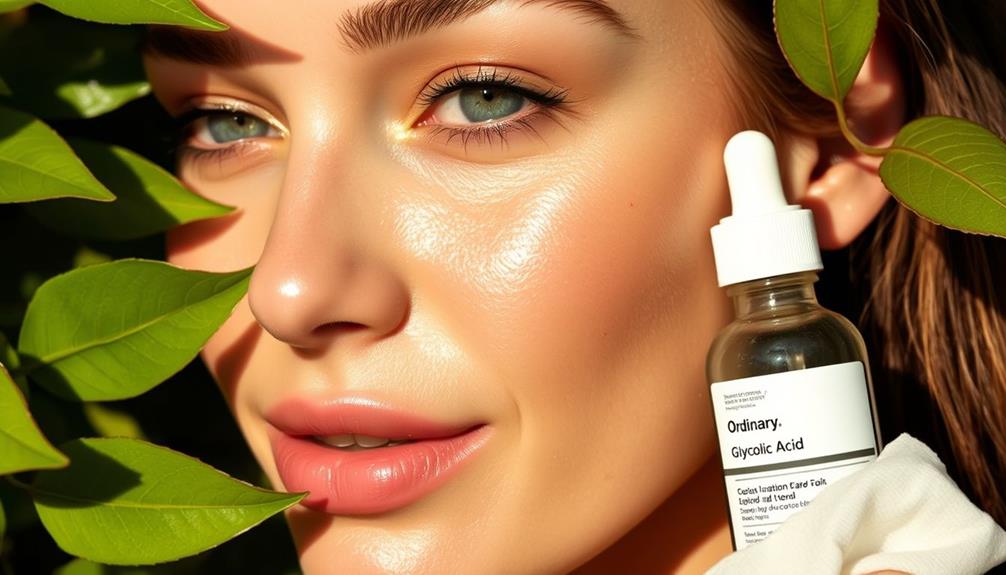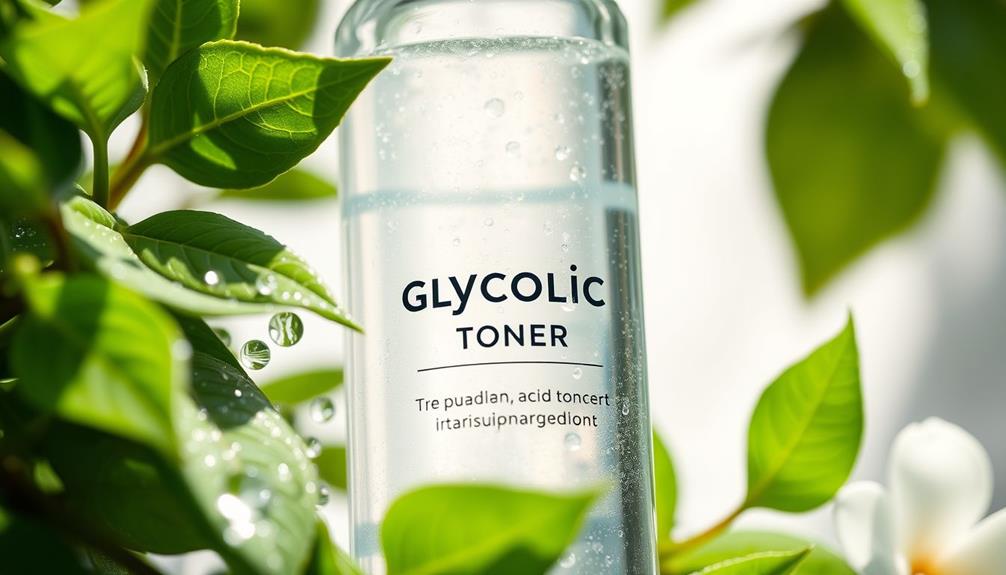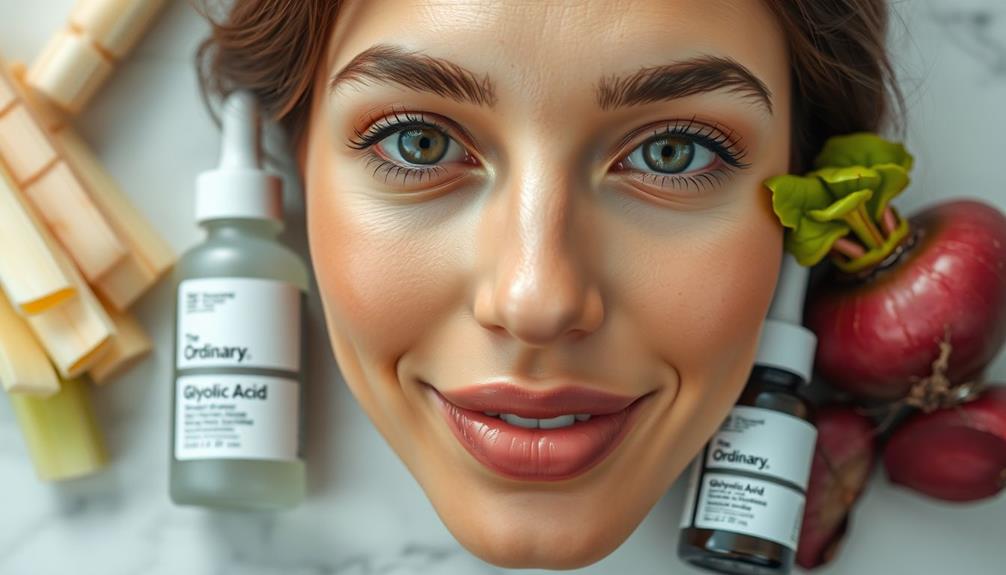Glycolic acid is an effective skincare ingredient that can significantly enhance your skin’s appearance. It works by accelerating cell turnover, which helps fade dark spots and diminish fine lines. With regular use, you’ll see a boost in radiance and improved skin firmness as it encourages collagen production. Not only is it beneficial for those with acne-prone skin, as it helps prevent clogged pores and breakouts. To avoid any irritation, start with a lower concentration and gradually increase the strength. Also, remember to always use daily sunscreen, as glycolic acid can increase your skin’s sensitivity to the sun. Stay tuned for more tips on incorporating glycolic acid into your skincare routine!
Key Takeaways
- Glycolic acid exfoliates the skin, promoting faster cell turnover for a healthier, more radiant complexion.
- It stimulates collagen production, enhancing skin elasticity and firmness to reduce fine lines and wrinkles.
- Effective for fading hyperpigmentation, glycolic acid helps achieve a more even skin tone by addressing dark spots.
- As a humectant, it attracts moisture to the skin, improving hydration levels and overall skin texture.
What Is Glycolic Acid?

Glycolic acid is a powerful alpha-hydroxy acid (AHA) from sugar cane that effectively exfoliates your skin by penetrating deeply and promoting faster cell turnover. This small molecular structure allows glycolic acid to dissolve the bonds between dead skin cells, revealing a fresher, healthier complexion.
Additionally, incorporating essential oils in your skincare routine can enhance your overall wellness and complement the effects of glycolic acid, as essential oils offer various benefits for skin health. As you incorporate glycolic acid into your skincare products—like cleansers, serums, and peels—you'll notice an improvement in your overall skin texture and tone.
Regular use of glycolic acid can greatly reduce the appearance of fine lines and wrinkles, giving your skin a smoother look. Its exfoliation properties also help to keep acne-prone skin in check by preventing clogged pores and reducing breakouts.
Additionally, glycolic acid aids in fading hyperpigmentation and dark spots, making it a versatile ingredient in your skincare routine.
With at-home formulations typically containing concentrations ranging from 5% to 10%, you can tailor the use of glycolic acid to suit your skin's needs. Whether you're aiming for a more radiant complexion or tackling specific skin concerns, incorporating glycolic acid can be a game-changer in achieving your skincare goals.
Key Benefits for Skin Health

Incorporating glycolic acid into your skincare routine offers numerous key benefits that can transform your skin health, from enhancing radiance to reducing the signs of aging. This powerful exfoliating acid accelerates cell turnover, loosening the bonds between dead skin cells, which results in a smoother, more radiant complexion.
Here's a quick overview of the benefits:
| Benefit | Description | Effect on Skin |
|---|---|---|
| Enhanced Radiance | Increases cell turnover for a brighter appearance | Smoother, glowing skin |
| Collagen Stimulation | Boosts collagen production for better elasticity | Fewer fine lines and wrinkles |
| Treatment of Hyperpigmentation | Fades dark spots and sun damage | More even skin tone |
| Acne Prevention | Exfoliates and prevents clogged pores | Reduced breakouts |
Regular use of glycolic acid can also improve skin hydration due to its humectant properties, attracting moisture to your skin. By incorporating this versatile ingredient, you're not just addressing current skin concerns but also investing in long-term skin health. Enjoy the benefits of glycolic acid and watch your skin transform!
Mechanism of Action

The exfoliating power of glycolic acid comes from its ability to loosen the bonds between dead skin cells, promoting quicker skin turnover and revealing fresher skin underneath.
Its small molecular size allows glycolic acid to penetrate the skin more deeply than other alpha-hydroxy acids, enhancing its exfoliating effects.
As it works to shed those dead skin cells, it also stimulates collagen production, which is essential for improving skin elasticity and firmness.
Moreover, incorporating natural elements like essential oils for skin can additionally enhance your skincare routine, providing nourishment and promoting overall skin health.
This boost in collagen not only helps your skin look youthful but also contributes to a smoother texture.
In addition, the pH-adjusting properties of glycolic acid in skincare products guarantee that they remain effective while minimizing potential irritation.
By exfoliating the surface layer, glycolic acid enhances the absorption of subsequent skincare products, making them more effective.
When you incorporate glycolic acid into your routine, you're not just exfoliating; you're actively promoting a healthier, more vibrant complexion.
The combination of its ability to penetrate the skin deeply, improve skin turnover, and stimulate collagen production makes glycolic acid a powerful ally in your skincare regimen.
How to Use Glycolic Acid
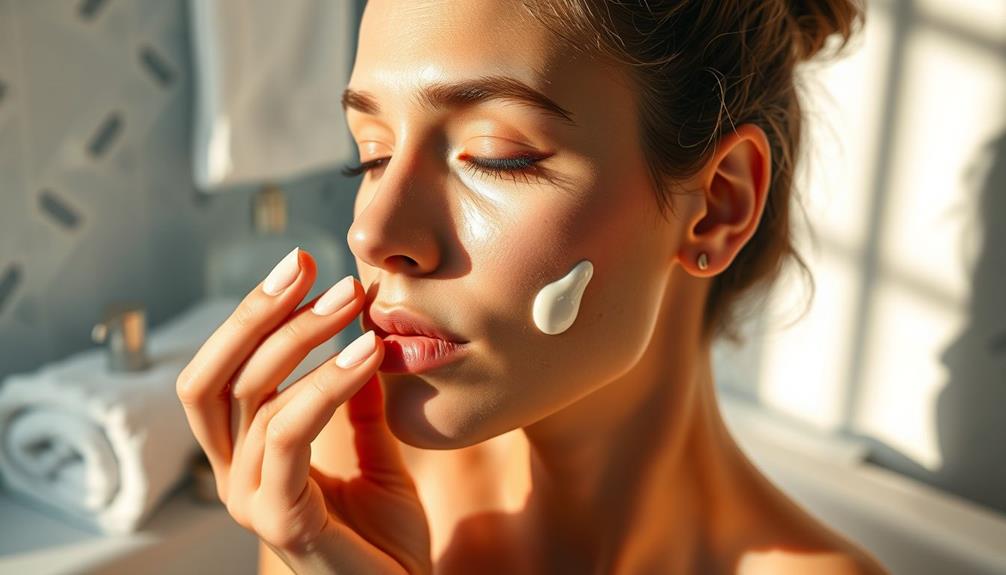
When using glycolic acid, start with a low concentration to see how your skin reacts.
It's crucial to maintain awareness of your body's responses during this process, similar to practices in self-exploration through body awareness found in somatic therapy.
Apply it in the evening and gradually increase the frequency as your skin adjusts.
Remember to always patch test before applying it more widely, especially if your skin is sensitive.
Best Application Practices
To achieve the best results with glycolic acid, start with a low concentration of around 5% and gradually increase as your skin adjusts. This approach helps you assess your skin tolerance and minimize irritation.
For enhanced skin benefits, consider incorporating gentle yoga stretches into your routine, as they can promote relaxation and improve overall skin health. Begin by using glycolic acid products three times a week, and pay attention to how your skin responds before adjusting the frequency.
Apply glycolic acid in the evening on clean, dry skin, and avoid any broken or irritated areas to prevent further irritation.
It's essential to pair glycolic acid with hydrating ingredients, like hyaluronic acid, to counteract potential dryness that may arise from exfoliation.
Always follow up with a broad-spectrum sunscreen during the day, as glycolic acid can increase your skin's sensitivity to sunlight.
Frequency and Concentration Guidelines
Understanding the right frequency and concentration of glycolic acid is key to achieving ideal skin benefits without irritation.
For at-home use, start with a glycolic acid concentration of 5% to 10%. If you're new to this ingredient, it's best to begin at the lower end to assess your skin tolerance.
Applying glycolic acid products in the evening can be particularly beneficial, as it minimizes sun sensitivity and allows for overnight rejuvenation. Additionally, maintaining a consistent skincare routine is essential, similar to how regular vet check-ups are vital for monitoring a cat's health and well-being regular vet check-ups.
Use glycolic acid two to three times per week initially. As your skin adjusts, you can gradually increase the frequency.
Keep an eye out for irritation; if you notice redness or discomfort, reduce how often you use the product or switch to a lower concentration.
Daily sunscreen is essential while using glycolic acid, as it can heighten photosensitivity, making your skin more vulnerable to UV rays.
Also, avoid using glycolic acid with strong exfoliants or retinoids at the same time. This helps prevent excessive irritation and sensitivity, ensuring your skin remains healthy and radiant.
Safety and Precautions

When using glycolic acid, you need to be aware of how it can increase your skin's sensitivity to sunlight, so daily sunscreen is a must.
Awareness of your skin's reactions is essential, especially since understanding narcissism can help you identify when external factors may be impacting your skin health.
Start with a lower concentration and gradually increase usage to minimize irritation, especially if you have sensitive skin.
Always monitor your skin for any adverse reactions and remember to patch test before applying it widely.
Skin Sensitivity Awareness
Glycolic acid can heighten your skin's sensitivity, so it's important to take proper precautions to protect your skin. When using glycolic acid, be aware that it can increase your sensitivity to UV rays, making daily sunscreen application necessary to prevent sunburn and long-term damage.
If you have sensitive skin, you might experience irritation such as redness, itching, or burning. To avoid this, consider patch testing before applying glycolic acid more broadly; this helps identify any allergic reactions or sensitivities.
Overuse of glycolic acid can lead to adverse effects, including hyperpigmentation and worsening skin conditions, particularly if you have darker skin tones. It's essential to monitor how your skin reacts to the product and adjust your usage accordingly.
If you have pre-existing skin conditions or concerns, consulting a dermatologist is advisable. They can provide tailored guidance to guarantee safe and effective use of glycolic acid.
Gradual Usage Recommendations
To safely incorporate glycolic acid into your skincare routine, start with a low concentration and gradually increase usage to minimize irritation. Begin with a glycolic acid product containing around 5% concentration, applying it no more than three times a week. This approach helps your skin acclimate without overwhelming it.
Here's a quick reference table for your gradual usage recommendations:
| Step | Action | Frequency |
|---|---|---|
| Step 1 | Start with low concentration | 1-2 times per week |
| Step 2 | Gradually increase frequency | Up to 3 times per week |
| Step 3 | Monitor skin reaction | Adjust as necessary |
Always apply glycolic acid products in the evening to reduce the risk of increased sun sensitivity. Remember to perform patch testing before full application to identify any adverse reactions. If you have sensitive skin or pre-existing conditions, a consultation with a dermatologist is essential to guarantee safe and effective use. Finally, always follow up with a broad-spectrum sunscreen during the day to protect your skin.
Sunscreen Importance
Daily sunscreen use is essential for protecting your skin from UV damage, especially after incorporating glycolic acid into your routine.
Glycolic acid, an alpha hydroxy acid (AHA), increases your skin's sensitivity to UV rays, making you more susceptible to sunburn and long-term skin damage.
To combat this, choose a broad-spectrum sunscreen with an SPF of at least 30, which helps prevent premature aging and hyperpigmentation caused by sun exposure.
Apply sunscreen every morning, regardless of the weather, and make sure to reapply every two hours when you're outdoors.
This practice is imperative to safeguard your skin from cumulative UV exposure, which can worsen existing skin concerns.
If you have acne-prone skin, opt for a non-comedogenic sunscreen to avoid clogging your pores.
Even if you're using glycolic acid products at night, don't skip the sunscreen during the day.
Protecting your skin daily is essential for maintaining its health and appearance.
Common Side Effects
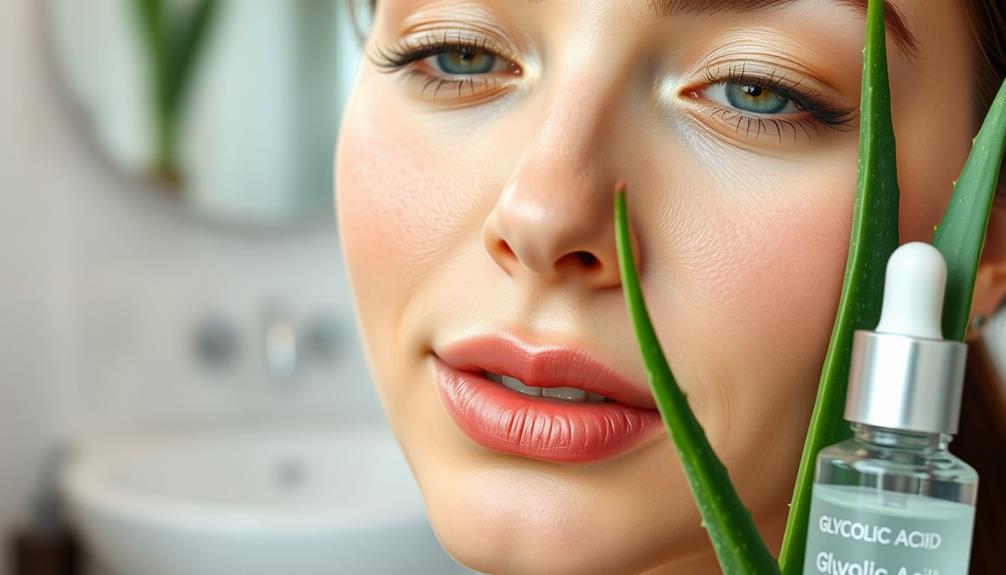
Using glycolic acid can lead to common side effects like redness, itching, and burning, especially for those with sensitive skin.
When you first start using this potent alpha hydroxy acid (AHA), your skin might react with irritation or excessive dryness, which is why it's important to introduce it gradually into your routine.
Overusing glycolic acid or using high concentrations can exacerbate these effects, leading to peeling and discomfort.
Another significant aspect to keep in mind is photosensitivity. Glycolic acid increases your skin's vulnerability to UV rays, making daily sunscreen application critical to protect against sun damage.
If you experience irritation, it could lead to hyperpigmentation, particularly in darker skin types, as inflammation can trigger darker patches.
Most adverse reactions to glycolic acid are mild and temporary, but it's crucial to monitor your skin's response.
If you notice severe irritation or signs of an allergic reaction, stop using the product immediately and consult a dermatologist.
Glycolic Acid Vs. Other Acids

When comparing glycolic acid to other acids, it's essential to understand their differences.
Glycolic acid, an AHA, excels at exfoliating the skin's surface, while BHAs like salicylic acid work deeper in the pores to combat acne.
You'll find that glycolic acid's potency makes it a go-to for enhancing skin texture and addressing signs of aging more effectively than some other acids.
AHA Vs. BHA Differences
Understanding the key differences between AHAs like glycolic acid and BHAs such as salicylic acid can help you choose the best exfoliant for your skin type and concerns.
Glycolic acid is an alpha-hydroxy acid that's water-soluble, making it ideal for exfoliating the skin's surface. It effectively improves skin texture by breaking down dead skin cells and enhancing hydration. Because of its small molecular size, glycolic acid can penetrate the skin more deeply than many other AHAs, providing quicker results.
On the other hand, BHAs like salicylic acid are oil-soluble, allowing them to penetrate deeper into the pores. This makes them particularly effective for addressing acne-prone skin by targeting oil and unclogging blocked pores. While AHAs, including glycolic acid, are excellent for normal, combination, and oily skin types, BHAs are better suited for those dealing with excess oil and inflammation.
Both AHAs and BHAs can be used together in a skincare routine, offering a balanced approach. Just remember to proceed with caution to avoid over-exfoliating your skin.
Efficacy of Glycolic Acid
Glycolic acid stands out among exfoliating acids due to its superior penetration and effectiveness in rejuvenating the skin compared to other AHAs and BHAs. As the smallest alpha-hydroxy acid, it offers exceptional exfoliation, promoting skin rejuvenation by effectively dissolving the bonds between dead skin cells. This accelerates cell turnover, allowing for fresher, brighter skin.
When it comes to addressing hyperpigmentation and acne, glycolic acid shines. Clinical studies show it considerably reduces fine lines and wrinkles while enhancing collagen production more effectively than beta hydroxy acids like salicylic acid. Its ability to stimulate collagen not only improves texture but also contributes to skin firmness.
Moreover, glycolic acid's humectant properties mean it also enhances skin hydration. Unlike some other exfoliating acids that may leave your skin feeling dry, glycolic acid maintains moisture levels, ensuring your skin stays soft and supple.
You can enjoy the benefits of glycolic acid at home with concentrations of 5%-10%, while higher concentrations up to 70% are available in professional treatments for more dramatic results. This versatility makes glycolic acid an excellent choice for anyone looking to improve their skin's appearance.
Choosing the Right Products
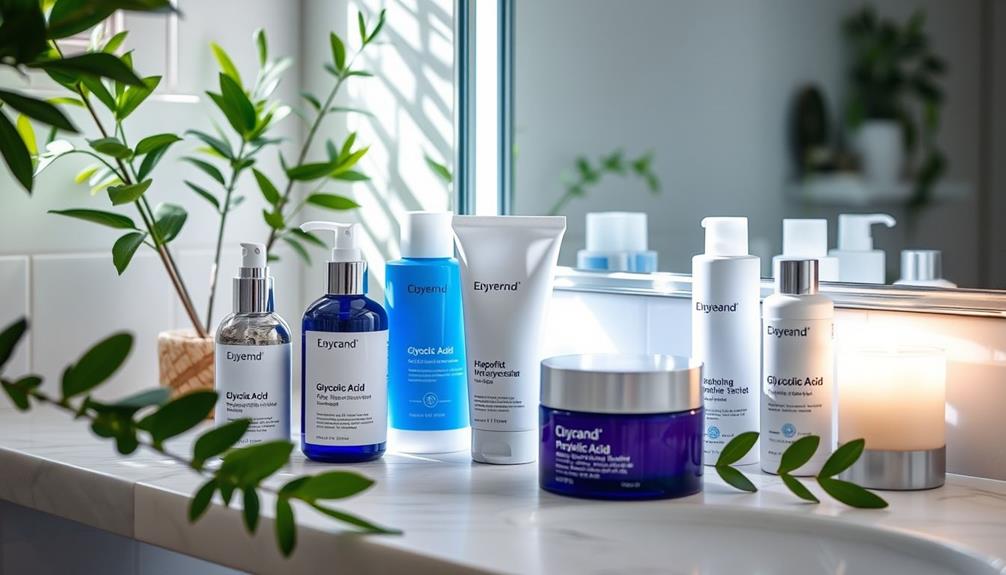
How do you select the best glycolic acid products for your skincare routine?
Start by looking for glycolic acid products with concentrations between 5% to 10%. This range is effective for at-home use while minimizing the risk of irritation.
Pay attention to the product's pH level, aiming for a pH around 4, which aligns closely with your skin's natural acidity for ideal results.
For better efficacy, consider choosing leave-on formulations like serums or toners. These allow the glycolic acid to stay in contact with your skin longer, enhancing its benefits.
If you're new to glycolic acid, begin with a glycolic acid cleanser to help your skin adapt before moving on to stronger leave-on products.
Treatment for Acne and Scarring
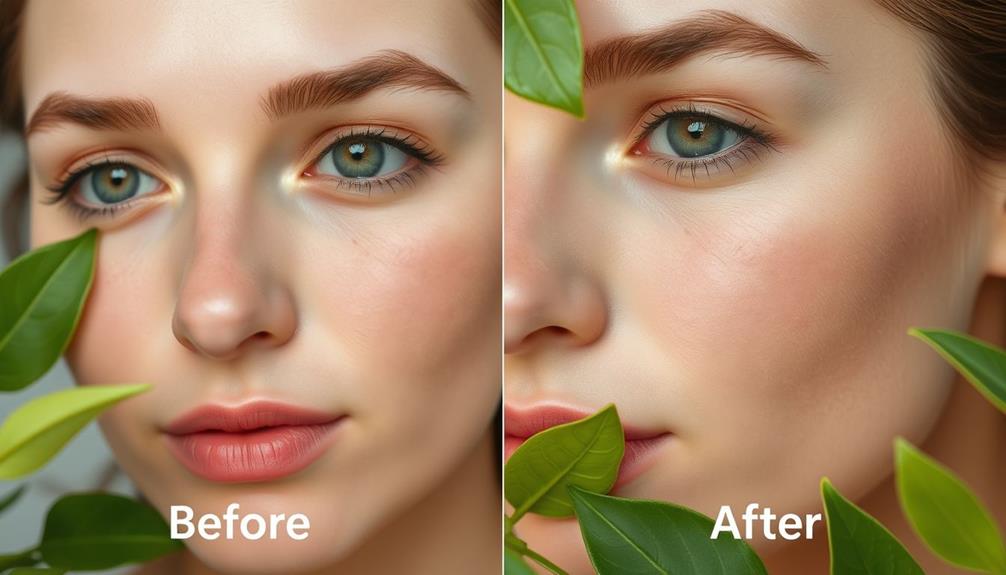
Incorporating glycolic acid into your skincare routine can effectively treat acne and reduce the appearance of scarring.
This powerful ingredient works by exfoliating the skin surface, preventing clogged pores that lead to acne breakouts. By regularly using glycolic acid, you'll notice fewer comedonal acne formations as your skin maintains a clearer complexion.
Moreover, glycolic acid is known for its ability to soften raised and pitted scars, making it a valuable ally in your journey toward smoother skin. While it can't completely remove scars, it greatly improves their appearance over time. You'll also benefit from reduced hyperpigmentation and dark spots left behind by acne, promoting a more even skin tone.
One of the key advantages of glycolic acid is its ability to stimulate collagen production. This process enhances skin elasticity and firmness, further contributing to the reduction of acne scarring.
If you're considering more intense treatments, remember that professional chemical peels can offer higher concentrations of glycolic acid for even more pronounced results. With consistent use, you'll be well on your way to achieving clearer, healthier skin.
Professional Vs. At-Home Use
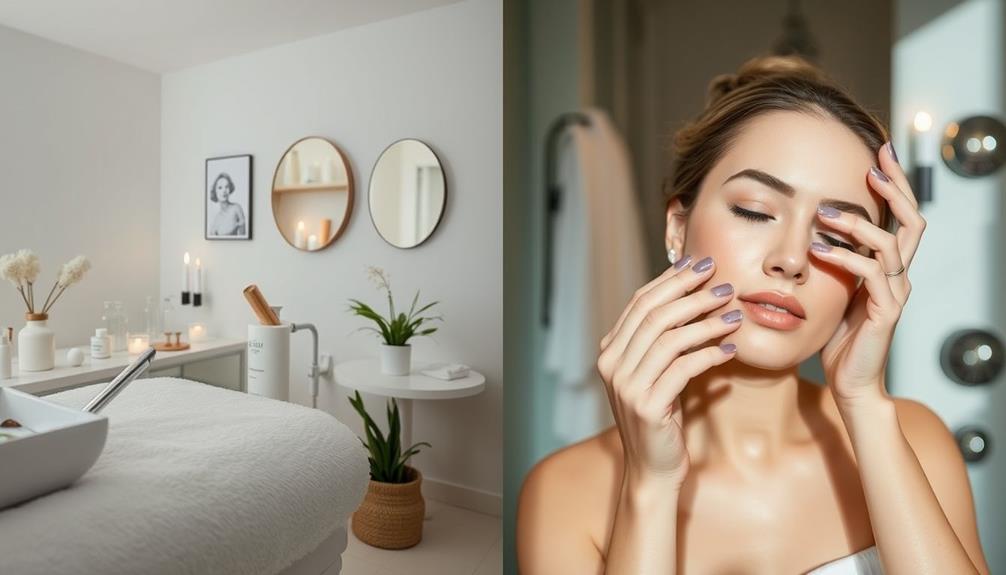
Choosing between professional glycolic acid treatments and at-home products can greatly impact your skincare results.
Professional treatments offer higher concentrations of glycolic acid—up to 70%—which can lead to faster, more impressive outcomes. These sessions allow professionals to customize treatment based on your specific skin types and concerns, ensuring that the exfoliation is effective while minimizing irritation.
On the other hand, at-home products typically contain lower concentrations, ranging from 5% to 10%. This gentler approach facilitates gradual skin exfoliation, making it easier for you to integrate these products into your daily routine without overwhelming your skin. At-home options, like cleansers, toners, or serums, are perfect for maintenance between professional treatments, helping you sustain the benefits achieved during those sessions.
Ultimately, if you're looking for immediate results and tailored care, professional glycolic acid treatments might be your best bet. However, if convenience and ongoing skincare are your priorities, at-home products can effectively support your goals while keeping irritation at bay.
Balancing both approaches can provide ideal results for your skin.
Frequently Asked Questions
What Does Glycolic Acid Do to the Face?
Glycolic acid exfoliates your skin, breaking down dead cell bonds and revealing a fresh complexion. It boosts collagen production, brightens skin tone, hydrates, and helps prevent acne, giving you a smoother, more youthful appearance.
How Long Does It Take to See the Benefits of Glycolic Acid?
You can start noticing improvements in skin texture and brightness within 2 to 4 weeks. For significant reductions in fine lines, expect results around 4 to 6 weeks with consistent use. Patience is key!
Does Glycolic Acid Make You Look Younger?
Yes, glycolic acid can make you look younger. It boosts collagen production, improves skin texture, reduces fine lines, and brightens your complexion. With regular use, you'll notice a more youthful, radiant appearance.
Does Glycolic Acid Remove Dark Spots?
Studies show glycolic acid can reduce dark spots by up to 50% with regular use. It promotes cell turnover, helping to fade discoloration over time, although complete removal may require professional treatments for deeper pigmentation.
Conclusion
Incorporating glycolic acid into your skincare routine can be a game-changer for your complexion.
Did you know that studies show glycolic acid can improve skin texture by up to 50% in just a few weeks?
By gently exfoliating and promoting cell turnover, it helps reveal a brighter, smoother face.
Just remember to start slow and choose the right products for your skin type.
Embrace the power of glycolic acid and watch your skin transform!




